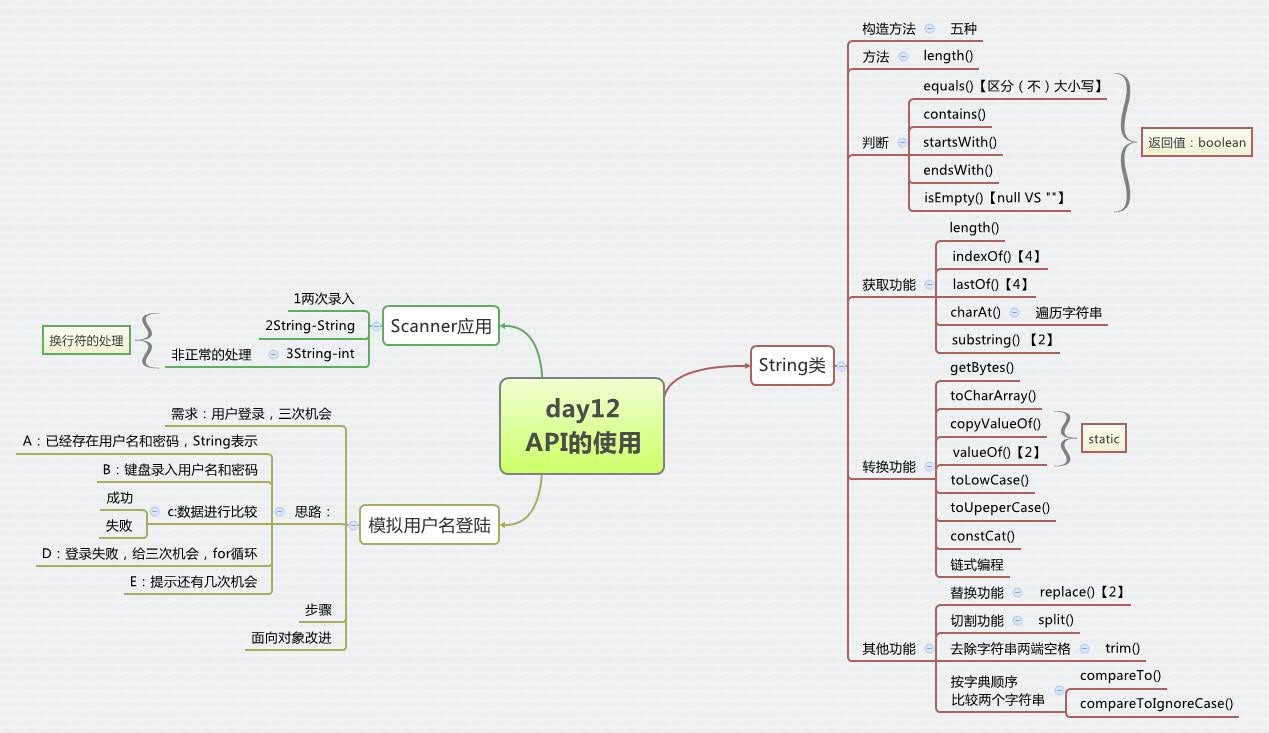
讲课流程:
API的使用:
1,Scanner的应用
两次录入: int -----int :
String --- String: 是结束标识符
String --- int:
int ----- String:不正常[2] 与String --- String有点理解不过来
1,sc重新赋值;
2,两次录入String类型,对第一个进行转换 *
/*
是在String中是结束标识符;但是在录入的开始并没做换行符录入的区别;
先输int, 是结束标识符,但是没有纳入int数组里;接下来的String读取开始则从 开始。
*/
2,String类【构造方法】
字符串定义:
空串:String s1 = "";//有对象,但是内容为空
null:String s2 = null;//没有对象
String()
String(byte[] bys)
String(byte[]bys,int offset,int length)
Stringchar[]value)
String(byte[]value,int index,int count)
String(String str)
3,String【方法】
length();
A:字符串一旦被初始化就不能被改变;【实际内容不可以改变,但是引用[地址值]改变了】
注意:这里指的是字符串在常量池里面的值是不能改变的,而不是字符串的引用不能改变
B:String s1 = new String("abcde"); 与 String s2 = "abcde";的区别:
a:在内存中有两个对象存在;
b:在内存中只有一个对象存在。
判断方法:
boolean equals(Object obj):判断字符串的内容是否相同,区分大小写。
boolean equalsIgnoreCase(String str):判断字符串的内容是否相同,不区分大小写。
boolean contains(String str):判断字符串对象是否包含给定的字符串。
boolean startsWith(String str):判断字符串对象是否以给定的字符串开始。
boolean endsWith(String str):判断字符串对象是否以给定的字符串结束。
boolean isEmpty():判断字符串对象是否为空。数据是否为空。
String s1 = ""; String s2 = null;
Sop(s1.isEmpty());//true
Sop(s2.isEmpty());//NullPointerException
4,模拟登录【实例】
A:需求
B:思路
C:实现步骤
1 package it.cast_01; 2 3 import java.util.Scanner; 4 5 public class UserDemo { 6 public static void main(String[] args) { 7 //用户名和密码已有 8 String username = "admin"; 9 String passward = "admin"; 10 Scanner sc = new Scanner(System.in); 11 for (int i = 0; i < 3; i++) { 12 //键盘录入用户名和密码 13 System.out.println("请输入用户名:"); 14 String un = sc.nextLine(); 15 System.out.println("请输入用户密码:"); 16 String pw = sc.nextLine(); 17 18 //判断 19 if(username.equals(un) && passward.equals(pw)){ 20 System.out.println("恭喜您成功登陆!"); 21 //此处可以添加应用代码【猜数字的游戏】 22 break; 23 } 24 else 25 { 26 if(i==2) 27 System.out.println("您的卡已锁,请寻找人工帮助!"); 28 else 29 System.out.println("登录失败,你还有"+(2-i)+"次机会!"); 30 } 31 } 32 } 33 }
5,String【方法】
获取方法:
int length():获取字符串的长度
char charAt(int index):返回字符串中给定索引处的字符
int indexOf(int ch):返回指定字符在此字符串中第一次出现的索引
int indexOf(String str):返回指定字符串在此字符串中第一次出现的索引
int indexOf(int ch,int fromIndex):返回在此字符串中第一次出现指定字符的索引,从指定的索引开始搜索。
int indexOf(String str,int fromIndex):返回在此字符串中第一次出现指定字符串的索引,从指定的索引开始搜索。
String substring(int start):截取字符串。返回从指定位置开始截取后的字符串。
String substring(int start,int end)截取字符串。返回从指定位置开始到指定位置结束截取后的字符串。
【包左不包右】
对字符串操作完成,原字符串并不更改。
实例题:统计字符串中字符个数
1 package it.cast_03; 2 3 import java.util.Scanner; 4 5 /** 6 * 统计字符串中各种字符个数 7 * @author itcast_03 8 * 9 */ 10 public class CharCount { 11 public static void main(String[] args) { 12 //第一种: 13 //原始字符串 14 String s = "Hello12345World"; 15 //统计变量命名及初始化 16 int uperCount = 0; 17 int lowCount = 0; 18 int numCount = 0; 19 //遍历字符串字母 20 for(int i=0;i<s.length();i++) 21 { 22 char ch = s.charAt(i); 23 //每个字母进行判断 24 if(ch>=97 && ch<=122) 25 lowCount++; 26 else if(ch>=65 && ch<=90) 27 uperCount++; 28 else if(ch>=48 && ch<=57) 29 numCount++; 30 } 31 //最终结果输出 32 System.out.println("大写字母有:"+uperCount); 33 System.out.println("小写字母有:"+lowCount); 34 System.out.println("数字字母有:"+numCount); 35 36 //第二种,优化 37 //键盘录入字符串 38 Scanner sc = new Scanner(System.in); 39 System.out.println("请输入待查询字符串:"); 40 String s1 = sc.nextLine(); 41 System.out.println(s1); 42 43 //统计变量命名及初始化 44 uperCount = 0; 45 lowCount = 0; 46 numCount = 0; 47 48 //遍历字符串字母 49 for(int i=0;i<s1.length();i++) 50 { 51 char ch = s1.charAt(i); 52 //每个字母进行判断 53 if(ch>='a' && ch<='z') 54 lowCount++; 55 else if(ch>='A' && ch<='Z') 56 uperCount++; 57 else if(ch>='0' && ch<='9') 58 numCount++; 59 } 60 //最终结果输出 61 System.out.println("大写字母有:"+uperCount); 62 System.out.println("小写字母有:"+lowCount); 63 System.out.println("数字字母有:"+numCount); 64 65 } 66 }
转换功能:
byte[] getBytes():把字符串转换成字节数组。
char[] toCharArray():把字符串转换成字符数组。
static String copyValueOf(char[] chs):把字符数组转换成字符串。
static String valueOf(char[] chs):把字符数组转换成字符串。
static String valueOf(int i)基本类型:把int(基本类型)转换成字符串。
String toLowerCase():把字符串变成小写
String toUpperCase():把字符串变成大写
String concat(String str):拼接字符串。
链式编程
实例:将字符串首字母大写,其余字母小写
1 package it.cast_05; 2 /** 3 * 字符串首字母大写,其余字母小写 4 * @author Administrator 5 * 6 */ 7 public class ChangeTrain { 8 public static void main(String[] args) { 9 //原始字符串 10 String s = "HELLoworld"; 11 //将首字母截取并变大写 12 String s1 = s.substring(0,1).toUpperCase(); 13 //将其余字符提取出来并变小写 14 String s2 = s.substring(1).toLowerCase(); 15 //转换完的字符串拼接 16 s = s1.concat(s2); 17 System.out.println(s); 18 //链式编程 19 String s3 = s.substring(0,1).toUpperCase().concat(s.substring(1).toLowerCase()); 20 System.out.println(s3); 21 } 22 }
其他功能:
替换功能
String replace(char oldChar,char newChar):用新的字符去替换指定的旧字符
String replace(String oldString,String newString):用新的字符串去替换指定的旧字符串
切割功能
String[] split(String regex)
去除字符串两端空格
String trim()
按字典顺序比较两个字符串
int compareTo(String str)
实例:大字符串中截取小字符串
【用少一个字符的字符串替换,然后比较两个字符串长度】
思路:A:定义两个字符串,一个大串,一个小串。
B:在大串中查找第一次出现的索引;没有,这查询完成;出现,则计数器加1;
C:记住上次查询的索引记住,从索引加上小串长度截取字符串;
D:返回B。